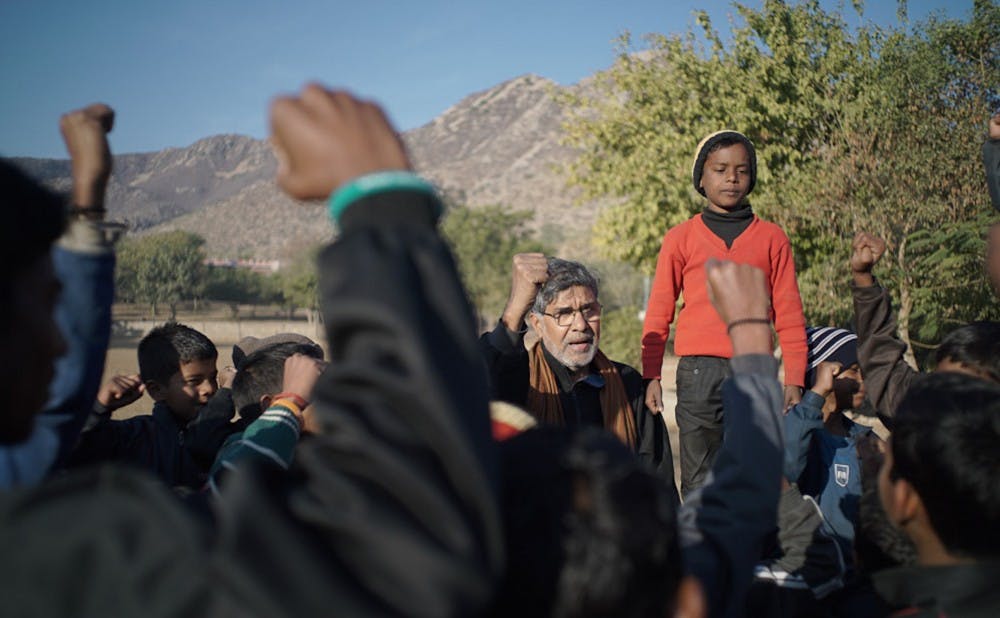The senses are immediately overwhelmed as the camera pans across Delhi’s bustling city streets. Cutting to concealed body cameras and shaky handheld cameras, the audience is immediately propelled into a factory raid as Bachpan Bachao Andolan officials and law enforcement shout commands, forcibly burst through doors and ultimately lock in on an unassuming pile of trash bags. Behind those bags, dozens of terrified children are discovered and rescued from a long-standing child slavery operation.
Derek Doneen's “Kailash” has the trappings of a gripping action tale with cinematic adornments ranging from animated flashback sequences to intricate raid plots — a refreshing take on the social justice documentary. Scoring best U.S. Documentary at Sundance Film Festival, “Kailash” follows Nobel Peace Prize recipient Kailash Satyarthi, founder of the BBA (Save the Childhood Movement), which is credited to have rescued and rehabilitated more than 85,000 children from slavery since 1980. Satyarthi and his family have endured death threats and have witnessed the murder of numerous colleagues during public demonstrations but persevere in the name of justice.
“Why are some people are born to work at the expense of their childhood?” Kailash poses at the beginning of the film. We were left to ponder that question as countless tragedies unfold before our eyes. Without the BBA, it would be difficult for the Indian government to enforce its policies against child slavery. Many cases go ignored or unchecked, as local law enforcement are often bribed by factory-owners to keep quiet about underground slavery rings.
The film denounces this corruption and reveres education. Satyarthi stresses to the rescued children that the system is not built to benefit them and the only way out is to pursue an education — no matter how desperate times become. This idea may seem obvious to those privileged with easy access to education, but is dubious to those who must choose between a day at school and a day earning their bread. It is much easier to invest in the near, demanding present than in an uncertain distant future.
In viewing a documentary that details atrocities against human rights, often the audience is reduced to passive spectatorship. There remains a detachment between filmmaker and subject and thus a degree of disillusionment from a jaded audience. With “Kailash,” there is an unmistakable distance between the filmmaker and the subject and perhaps even a sense of non-intervention, but the documentary seems to be reaching out to its viewers, saying, “you, too, can be a part of this change,” actively engaging the audience thrust in the center of the action.
“Kailash” is awash with pathos. On either side of me I could hear the sniffles of fellow audience members as the heartbreaking stories of the children rescued by the BBA struck us with both shock and disgust at the corrupt and broken system — even I struggled to choke back tears. The documentary exposes brands many of us know and utilize. One child suffered chemical burns from bottling products at a Vaseline factory while another faced serious back and joint complications from stooping over to assemble Zara accessories for twenty hours a day. The documentary urges consumers, in its tragic and emotional discourse, to avoid passive consumerism — but is this a realistic solution?
When Satyarthi himself addressed the audience following the screening of the documentary to take individual responsibility in ensuring their goods are produced free of child labor, the audience erupted in affirmative applause. But, as I paused to look around the room, I noticed an undeniably uniform demographic. The crowd was nearly all white, made up mostly of wealthy Sundance ticket-holders. Sure, it may be easy for them to make a dramatic shift in lifestyle and cost of living to accommodate such a cause but what about the rest of America — low-income America? How could they too participate in such a pressing and worthwhile mission?
Of course, demonstrating cognizance in consumer choice is a noble venture that those who have the means should surely pursue but individual action is no match for collective activism. Often, brands that produce goods without ties to slavery are a greater expense to low-income individuals. Although low-income individuals may desire to act, they are inhibited by larger economic forces at play.
What the documentary fails to address is how the goals of this movement can be more inclusive and attainable. Perhaps a shift toward changing policy rather than individual choice may be more effective. Bad publicity and pressure from constituents and consumers on companies and the government as a collective have been successful in the past and could certainly hold true in this instance.
“Kailash” has its limitations as an exposé and as a historical timeline of events. It provides a snapshot of the day-to-day operations of the BBA, taking place over the course of a few weeks. “Kailash” does offer some backstory, but unlike a piece of extended reporting, it only surrenders an illusion of progress in the lives of the rescued children from the opening scene.
Yet the lack of closure or a finite solution allows for speculation on the future of the movement. It calls on viewers to devise their own solutions and take on the responsibility of helping free the 152 million child slaves worldwide. “Kailash,” perhaps erring on the side of a glossy awe-inspiring documentary rather than a gritty investigative piece, offers viewers a beacon of hope. It may fall into oversimplification at times, but it ultimately succeeds in its emotional reach.
Get The Chronicle straight to your inbox
Sign up for our weekly newsletter. Cancel at any time.

